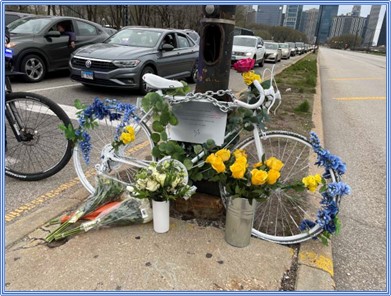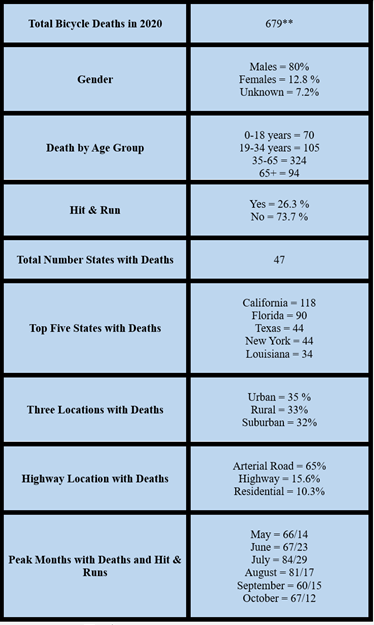
A memorial to a cyclist who was killed by a vehicle driver running a red light. Photo by David Schaper/NPR.
“Wilderness is a necessity…there must be places for human beings to satisfy their soul” -John Muir
Case Report 31 July 2023
Recently, a 17-year-old male was killed by a car while cycling near Boulder, Colorado. As a national team bicyclist, he was training for an upcoming international mountain bike cross-country competition. The crash happened about 12:33 p.m. on Highway 119 according to Colorado State Highway Patrol. A 23-year-old female was driving southbound when the vehicle veered into the wide shoulder, hitting the back of the bike. The investigation indicates that drugs, alcohol, and excessive speed do not appear to be factors in the crash. However, there is a possibility that distracted driving remains a possible cause.
There is growing awareness of the tragic rise of vehicular crashes with bicyclists causing approximately 1,000 deaths and 130,000 injured annually. The causes of bicyclist trauma are multifactorial, but the evidence indicates they are caused by a significant number of vehicle drivers who are distracted. Common distractions are any actions that divert the driver's attention, such as eating, children, reading emails and texting. Similarly, pedestrian fatalities caused by reckless drivers have skyrocketed with 7,485 deaths in 2021, the highest in four decades. This trend begs the question, is it time to get off the streets and transition to off-road mountain bike (MTB) trails as a safer alternative for recreational cycling? Well maybe, it just depends on many factors. Ironically, many road cyclists think MTB riding is too dangerous and too risky, and MTB riders say the same about road biking.
Based on these tragedies, Outside magazine staff worked with Geospatial Research Solution and the nonprofit BikeMaps.org to develop a digit tool to map cycling deaths in 2020 for a project called #2020CyclingDeaths. Here is what they learned, as published in Outside, from the data collected and summarized in Table 1.

Table 1. Breakdown of bicycle deaths in 2020 as published by Outside magazine.
** Death only reported by media. Actual number is higher.
These data provide some clarity about who and where cyclists are being killed. It is typically males between ages 35-65 years with highest death rate. Cyclist fatalities occurs in nearly every major metropolitan and with nearly equal annual fatalities on urban highways, and rural roads. Most vehicular incidences with cyclists are unintentional, but malicious impact with cyclists does occur as seen on video recently in Las Vegas.
Understandably, your initial visceral reaction is to contemplate never to cycle again on any road near vehicles. Alternatively, a balanced option is to change from a road bike to one of several types of MTB and to ride dirt trails. There are many advantages of MTB riding, such as the joy and solitude of recreational riding through a variety of terrains and landscapes in wilderness locations including, forests, deserts, or high mountain ridgelines. Also, there are many designated MTB parks that are classified by surface terrain and riding difficulty. In general, there are three basic classifications for trail riding from easy to advanced: 1) flat or rolling cross-country trails; 2) all around mountain riding; and 3) downhill. Downhill riding is considered the most advanced and dangerous MTB riding, but all trail riding has its own hazards ranging from low to high injury risk.
The injury rate for MTB cycling on various terrain is widely variable. It is reported that the overall injury rate for recreational trail riding is low and ranges between 0.4 - 1.4 riders per 1,000-hour exposure. The injury rates for competitive cross-country riding are 7.5 and 3.1 per 1000-hour exposure for females and males, respectively. However, it is reported that the highest injury rates are 46.8 and 42.7 per 1000-hour exposure for females and males who are competitive downhill cyclists, respectively.
One study reported that the most common mechanism of acute severe injury during MTB competition is caused by falling forward (64.9%), and 85.6% of such injuries have occurred while riding downhill. In general, when falling forward over the handlebars, this leads to greater head and neck injury severity and longer hospital admissions when compared to falling to the side of the bike. Injuries from falls can range from minor soft tissue abrasions to lower and upper extremity fractures, head trauma, torso trauma, polytrauma, and death as MTB riding style becomes more advanced. Recently, a MTB crash causing torso injury was discussed in Wilderness & Environmental Medicine. Lower left abdominal trauma was caused by the cyclist falling forward, striking the end of the handlebar. Blunt injury from handlebars can cause solid organ lacerations, vascular thrombosis or dissection that can require emergent evacuation for surgical intervention. See a previous article in Wilderness Medicine Magazine that discusses a variety of injuries from aggressive weekend warrior MTB riding.
So, is MTB cycling a safer alternative to road cycling? The studies addressing this question are limited. However, one study conducted a retrospective review of severe injuries (Injury Severity Score (ISS) >12) from street cycling and MTB cycling (no breakout of style of MTB cycling) major trauma over a 14-year period; during the study period, a total of 11,772 severely injured patients for all-cause trauma were reported. There was a total of 258 (2.2%) bicycle injuries with a mean ISS of 17, hospital stays of 6 days, and a 7% mortality. Of the total injured, there were 209 persons injured from street cycling and 49 injured from MTB cycling. Street cyclists were often injured after being struck by a motor vehicle, and MTB cyclists were injured after a failed jump, bike tricks, or falls. It was concluded that in the trauma population studied, even though there were more street cyclists injured and killed, and despite the different style of cycling (street versus mountain), both groups displayed similar injury patterns, injury severity, and patient outcomes. The only exception is that spinal trauma was greater in MTB cyclists.
Another option many cyclists may consider is riding away from busy highways and riding on community paved trails. One example is the Washington & Old Dominion Rail Trail, a 45-mile trail in Virginia. Some excellent resources for searching for community trails are Rails to Trails or TrailLink; the latter includes pre-trip safe riding tips. These trails are great resource for communities, but they require responsible trail etiquette to remain safe, for example: “Share the Trail”: 1) Use safe speed; 2) Keep right and pass left; 3) Standing still, step aside; 4) Mind your pets; 5) Be alert; 6) Know and follow the rules. Furthermore, cyclists also should remain free of common distraction since many other pedestrians and other cyclists are distracted with earbuds, headphones and cellphones, etc.
Final Thoughts:
Recreational cycling on community paved trails or MTB rolling cross-country trails are safer options to road cycling. When seeking to ride on MTB trials, there are many recommendations to mitigate the injury risks. However, when cycling on aggressive terrain, the risk of severe injury increases. Compared to road cycling, the risk of death during all-terrain MTB riding is very low, but not uncommon, as the risks increase dramatically with falls over the handlebars. Any consideration to leave street cycling shouldn’t necessarily be a binary decision, that is, riding solely on the road or MTB trails. Consider a blend of cycling on road, community trails, and MTB trails as an option to decrease vehicular exposure. However, if one chooses to continue to ride on the road, there are essential recommendations for safer cycling when near vehicles and the inevitable distracted driver.